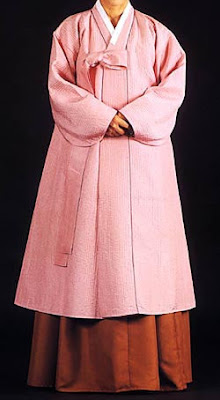Sunday, 24 July 2011
Hanbok
Here is my research and I have summarized it for my better understanding.
However I am not going to find out their complexity of royal history.
As I read from asianwoman, hanbok is the custom made of royal family, aristocrats, and commoners for all types of occasions including weddings, and funerals.
Basic hanbok
1. Jeogori (upper part)
-short and characterized by curved lines and delicate decorations.
2. DongJeong (white collar)
-contrasts and harmonizes with the overall curve of the neck.
3. Baerae (Jeogori Sleeve)
-a circular line which is naturally curved, similar to the line of the eaves of the traditional Korean house.
4. Otgoreum (strings)
-women's ornamental piece.
-hangs vertically across the front of the chima.
5. Chima (lower part)
-women's outer skirt.
-kinds of chima: single-layered, double-layered, and quilted.
-Pul-chima refers to a chima with a separated back.
-Tong-chima has a seamed back.
6. Rim /Dang'ui
-Traditional patterns graceful lines and color combinations enhance the beauty of the hanbok.
-Eg. Plant, animal, or other natural patterns.
***Undergarments-including sokbaji, sokchima, and mujigi to create fuller appearance look.
-sokbaji= brassiere
-sokchima= white and long chima
-mujigi= petticoat

Extra related item:
1. Gat-chogori
-rabbit fur lining the inside
-slightly bigger than an average chogori
-outside layer was made of silk.
2.Changot
 - dress code of Noble class females
- dress code of Noble class females
-cover their face and upper body whenever they went out in public.
-created a mysterious look.
 3. Ssukae Ch'ima
3. Ssukae Ch'ima
-shaped like a ch'ima but 30 centimeters shorter and somewhat narrower.
-white collar could be pinched in to hide ones face when a male approached.
4. Baeja
-a waistcoat or durumagi (a topcoat)
-protect themselves against the cold.
Royal family symbols:
1. A dragon represented an empress and a phoenix represented a queen.
2. Princesses and royal concubines wore floral patterns.
3. High ranking court officials wore clouds and cranes.
4. color gold was also reserved for royalty.
-Images of the 10 noble plants and animals representing longevity, luck, and wealth.
-Princesses' outfit
- bridal topcoat in wedding ceremonies (noble classes)
-extreme cost of making
-ceremonial topcoat (princess)
-marriage ceremonies (commoners)
-color and decorations around the chest, shoulders, and back represent the rank of the wearer.
-known as nok wonsam- green.
-minor ceremonial clothes (royal family)
-major ceremonies (noble classes)
-royal families had gold trim, while others had plain ones.
Accessories
1. Beoseon
-does not reflect any difference in the gender.
2. Jokduri
-ceremonial purpose
-Hard paper and cotton filling are covered with silk, and a cloisonne ornament is placed on the top.
3. Hwagwan
-ceremonial purpose.
-adorned with butterfly ornaments, five-colored beads, and gold thread, it is more lavish than jokduri
4. Jobawi
-winter cap
-made in black silk
-gems sometimes decorate the tassels. Gold gilt or beads were also used for decoration.
5. Ayam
-winter cap
-a long daenggi hangs on the back, which is called ayamdeurim.
sometimes decorated with jade or amber.
6. Daenggi
-ribbon used to tie and decorate long hair.
7. Dwikkoji
-accessory pinned on knotted hair
-practical use as it was used as an earpick and a stick to part hair.
8. Binyeo
-fasten a crown or a wig and hold braided hair up.
-the material and length of the binyeo varied according to the wearer’s class and status.
-the materials, shapes, sizes, and patterns of binyeo vary greatly.
9. Cheopji (top)
-ceremonial purpose
-often made with silver in the shape of a frog.
10. Tteoljam
-fluttering hairpins.
-formal hairdo, center and sides.
-circular or various shapes.
11. Baessi
-means "pit of a pear" (shape)
12. Wig/ gache
-women with high social backgrounds and gisaeng wore wig at 19th century.
-bigger and heavier wigs to be more desirable and aesthetic.
-royal court ladies used it every day, but commoners wore it only with ceremonial dress.
13. Tteoguji
-made with actual human hair (long time ago)
-after the prohibition on wigs, it was made with wood carved and painted in black in order to make it resemble human hair.
-lighter
14. Norigae
-hanbok's pendant
-It is tied to the outer goreum (a coat string)
-or the waist of a skirt and gives a luxurious look to the entire outfit.
-types of pendants are samjak norigae (a pendant with three ornaments) and danjak norigae (a pendant with one ornament).























Wow! This is so enlightening and helpful. I had great fun reading and as i did, i learned a lot; including distinguishing who wears what. Haha. Thank you so much! :))))
ReplyDeleteThank you :) I am glad to hear that.
DeleteMay be useful. God bless u ^_^